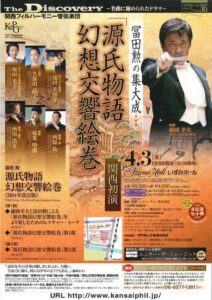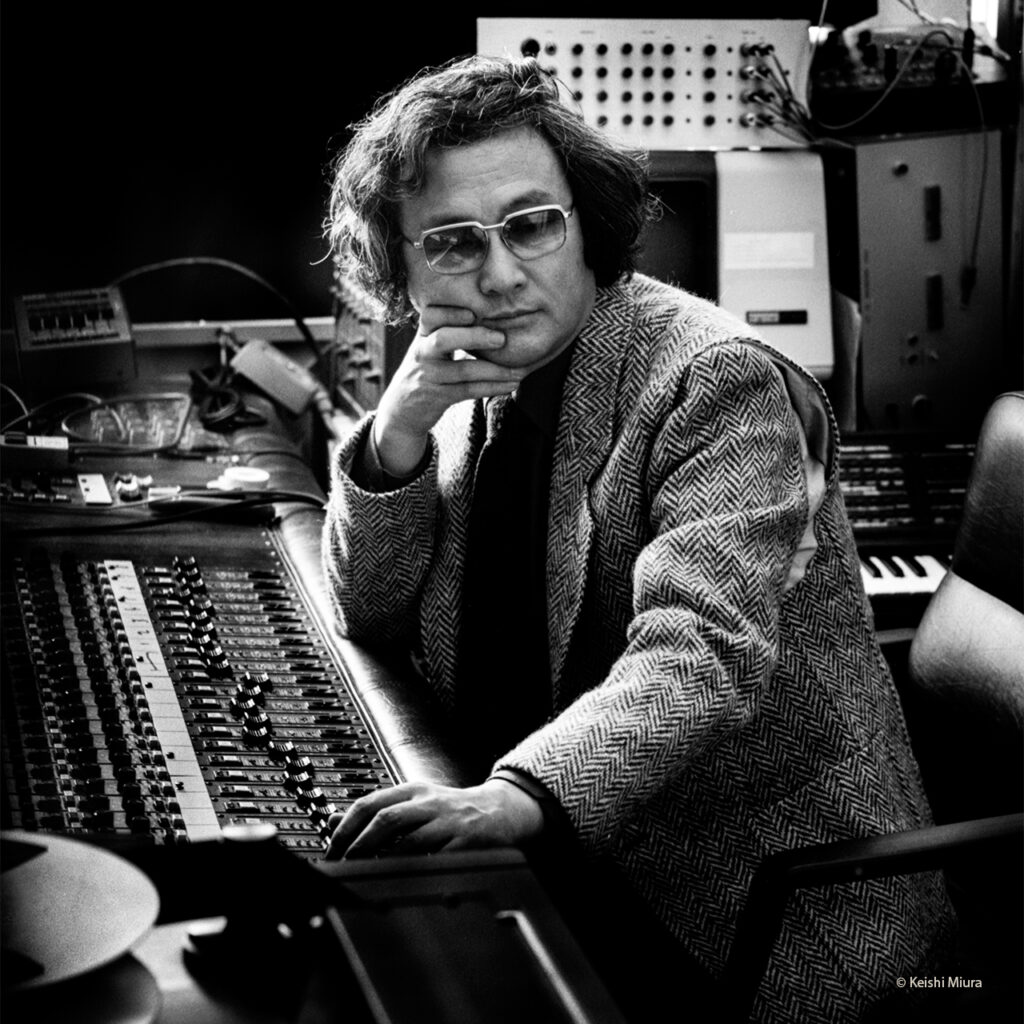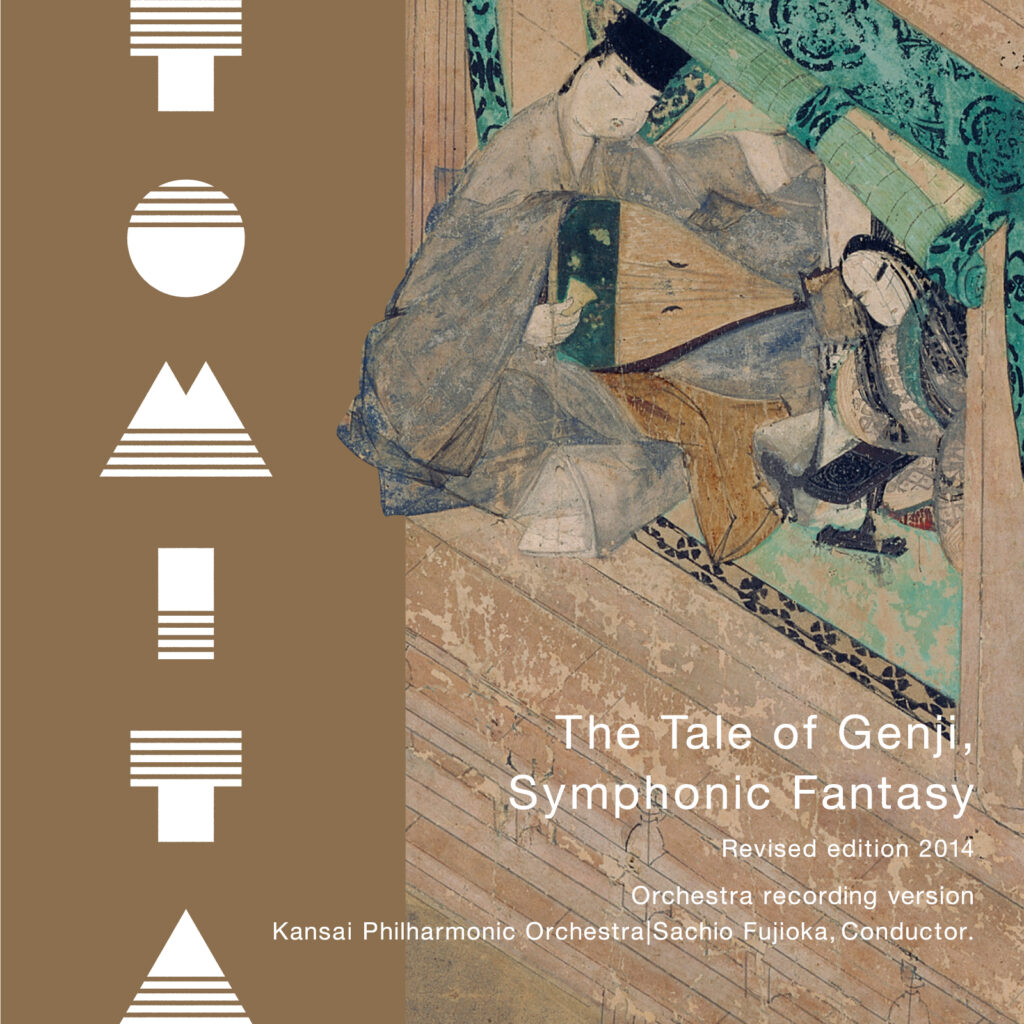Isao Tomita “The Tale of Genji: Symphonic Fantasy”
The Kansai Philharmonic Orchestra, under the direction of Yukio Fujioka
The Final Evolution of The Tale of Genji: Symphonic Fantasy by the Iconoclastic Composer Isao Tomita
The Tale of Genji: Symphonic Fantasy was released in November 2000 and is said to be the culmination of Tomita’s musical legacy. Even after its release, Tomita continued to refine the work through many more rounds of revision. The legendary live performance of the work on April 3rd, 2015 at Izumi Hall in Osaka with the Kansai Philharmonic Orchestra, under the direction of Yukio Fujioka, was recorded in a high-resolution, 3D format using the cutting-edge technology.
This album represents Japan not only in its combination of orchestral composition and traditional Japanese musical instrumentation, but also as an integration of Tomita’s own musique concrète, resulting in a finished product that emblemizes Japan in the 21st century. Its magnificent spatial presentation is noteworthy in its own right, and the advanced recording and mixing technologies allow the audience to enjoy sound fidelity that is as close as possible to what they would have experienced in the actual concert hall.

Commentary of Isao Tomita and Yukio Fujioka on the Composition on the Day of the Concert
A precious recording not included on the album. (in Japanese)

Isao Tomita
Renowned composer Isao Tomita was born in Tokyo, Japan in 1932.
While a student at Keio University, he studied composition under Kishio Hirao and Kojiro Kobune.
In the early 1950’s, Tomita began working as a composer and arranger in a range of fields including broadcasting, stage, movies and commercials. In 1974 his album Clair de Lune reached No. 2 on the Billboard Classics chart, and his next album Pictures at an Exhibition reached No. 1. Due to these achievements, the name “Tomita” achieved worldwide recognition. The year after he released this album, he became the first Japanese artist to be nominated for Grammy Awards in four categories, including Album of the Year.
Tomita’s canon of compositions includes many familiar songs that most listeners may recognize. Some of his notable contributions include theme music for TV productions such as NHK’s Hana no Shogai, Ten to Chi to, Shin Heike Monogatari, Katsu Kaishu, Tokugawa Ieyasu, Shin Nihon Kiko, Gendai no Eizo, Kaikyo and more. In the realm of film music he contributed music to A Fugitive from the Past, Prophecies of Nostradamus, Keishicho Monogatari Series and for animated films he scored Osamu Tezuka’s Jungle Emperor Leo, A Thousand and One Nights, Princess Knight, Dororo, Toei Animation’s Arabian Nights: Sinbad the Sailor, Gulliver’s Space Travel, and more.
In the 1960s and 70s, Tomita was one of the pioneers involved in developing 3D sound works. A representative example of his work includes the music for the Toshiba IHI pavilion at the 1970 Osaka World’s Fair. Another milestone came in 1984 when he organized the spectacular and enormously successful Tomita Soundcloud event, which enveloped the audience of some 80,000 people in a figurative universe of sound, utilizing the ground, the surface of the river, and the entire area above the Danube River in Austria to create super-stereophonic sounds. Since then, similar events have been held and resoundingly hailed around the world: The 1986 Statue of Liberty Centennial in New York , 1988 Chubu Mirai Expo in Gifu, Japan, The 1988 Australian Bicentennial in Sydney, Australia, and an event at the 1997 Chunichi Dome in Nagoya, Japan.
In 1998 he composed the original work The Tale of Genji: Symphonic Fantasy, which can be regarded as the culmination of Tomita’s work.
The work was released via performances by the London Philharmonic Orchestra and the Tokyo Symphony Orchestra.
Since initially creating The Tale of Genji: Symphonic Fantasy in 1998, Tomita revisited it many times up until the performance of the final version on April 3rd, 2015. This seminal performance in Izumi Hall in Osaka features narration in the Kyoto dialect and soloists performing on traditional Japanese instruments (This Work).
Tomita passed away on May 5th, 2016. The composer was engrossed in developing new work up until the time of his death.

©Tokugawa Art Museum Image Archive / DNPartcom
The Tale of Genji, Symphonic Fantasy
(Orchestra recording version)
Isao Tomita
Stereo & spatial audio compatible streaming format.
The available streaming services are subject to change due to AVID PLAY’s circumstances.
| Dolby Atmos | Amazon Music、Apple Music, etc. |
| Stereo | Spotify, Deezer, etc. |
©Shin Yamaguchi
In my opinion, this piece is unquestionably the masterpiece of the great composer Isao Tomita. I remember his response when I first played the mix in front of him. He said, “A lot of my work had been written specifically for studio recording, and I don’t have that many pieces designed for live performances. Two previously released versions of The Tale of Genji: Symphonic Fantasy were both based on recordings and weren’t optimized for future generations to perform. It was my dream to hand down this work as a piece that could be replayed by anyone.” Considering the fact that Mr. Tomita himself had attended practice sessions for the concert to give detailed instructions about the performance and accepted the edits and the provisional mix five years ago, it’s safe to say that this is the genuine performance reference and sound source for The Tale of Genji: Symphonic Fantasy. While it may be difficult for us to imagine this piece being replayed in the future due to its scale, I am sure that the late Mr. Tomita, who now resides in heaven, would be pleased to know that this audio recording could serve as inspiration for future performances.
(Excerpt from the Engineer’s Notes in the booklet)
Track List
| 1 | Overture | 00:05:20 |
| 2 | Spring Season – Cherry Blossom Viewing At The Palace/ Yearn After Lady Fujitsubo/ Throne Of Empress In The Palace | 00:10:44 |
| 3 | Garden/ Some Fun By Wind And Strings/ Out There In The World | 00:05:40 |
| 4 | Temple Prayers In The Northern Hill/ Lovely Maiden Murasaki | 00:08:53 |
| 5 | Lady Aoi/ Lady Rokujō/ Pageant To Kamo Shrine – Battle Of The Carriages | 00:10:10 |
| 6 | Spirit | 00:07:57 |
| 7 | The Third Princess | 00:08:04 |
| 8 | Think Of Fujitsubo | 00:01:38 |
| 9 | Dead Spirit Of Lady Rokujō/ Elegy Of Lady Murasaki/ Song “In The Vale Of Tears” | 00:10:32 |
| 10 | Ukifune | 00:09:55 |
| 11 | Entering The Nunnery/ Spring Returns | 00:07:21 |
| 12 | Finale – Reign Of Heike Begins | 00:04:17 |
Credit
- Performance:Kansai Philharmonic Orchestra
- Conductor:Sachio Fujioka(Principal Conductor of Kansai Philharmonic Orchestra)
- Narrator and Biwa:Yoshiko Sakata
- Biwa:Akiko Kubota
- So (25 Strings Koto):Michiko Takita
- Ryuteki and Shinobue:Kohei Nishikawa
- Hichiriki:Akinori Inaba
- Hichiriki and Sho:Yuji Nishihara
- Synthesizer:Katsunori Ujiie
- Recording / Mixing / Mastering:Hideo Irimajiri
©HIKAWA
I am very happy to present a new version to the world of The Tale of Genji: Symphonic Fantasy, which my father Isao Tomita so loved. It is of the wonderful concert performance from 2015 by the Kansai Philharmonic Orchestra conducted by Yukio Fujioka.
The latest technology was used for the recording to reproduce the beautiful world of the Heian period that I believe my father would particularly have liked to depict. The sadness of women playing Japanese instruments and metal chopsticks known as Myochin Hibashi in Japanese, along with the voice of Lady Rokujo, mad with jealousy, are dynamically and delicately reproduced in 3D audio, transcending space and time. I am truly grateful to everyone involved.
I hope this symphonic fantasy remains close to the hearts of many people long into the future.
Rie Seno

